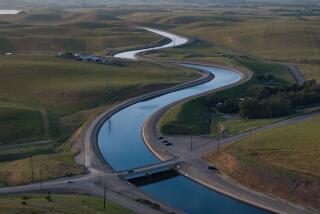Urban Areas to Get More Water : Supplies: Governor announces increase while cautioning that the drought is not history.
- Share via
Standing above the steep, barren shores of Castaic Lake, Gov. Pete Wilson on Friday announced a significant increase in state water deliveries for urban areas, but repeatedly cautioned Californians not to be lulled into thinking the five-year drought is history.
“It would be a serious mistake for anybody to think, ‘Well, let the good times roll,’ ” the governor said at a news conference overlooking the partly filled reservoir. “The drought’s not over--as this lake makes very clear.”
Wilson said that because of record rains in March, the basic allotment of State Water Project supplies for municipal and industrial use will be doubled--from 10% of normal, as previously announced, to 20%.
There was more good news for the giant Metropolitan Water District, which serves six counties in Southern California. The MWD will be permitted to buy an additional 215,000 acre-feet from a special state water bank, boosting MWD’s share of state water to roughly 33% of normal. An acre-foot of water is enough to supply a typical Los Angeles family of five for about 18 months.
Wilson also found 200,000 acre-feet in his water bank to sell to desperate growers of vines and nut trees in Tulare and Kern counties. Agriculture will remain cut off completely from the State Water Project this year. But Wilson said growers in the southern San Joaquin Valley who have no other water source to keep their trees and vines alive can purchase water from the state bank.
“Whole communities of mom-and-pop hardware and grocery stores, gas stations and school districts depend on agriculture,” he said. “If trees and vines are allowed to die, a significant part of California’s prosperity will also wither away.”
Mike Henry, a spokesman for the California Farm Bureau Federation, said the availability of hardship water from the state water bank is good news for many farmers served by the State Water Project. But such salvation does not come cheap, he added, noting that the water will cost $125 per acre-foot, plus additional delivery fees.
“It is exciting,” said Dennis Atkinson, vice president of Tejon Farming Co., which has 12,000 acres of nut trees and juice grape vines in Arvin. “It’s significantly better than zero. Before, no matter how much money you had, there was no water available from the state system. Now there’s some available at a price. And we have to determine if we can afford that price.”
Wilson announced that the state also will sell 50,000 acre-feet to San Francisco and 40,000 to Santa Clara County. Another 20,000 will be supplied for waterfowl refuges in the San Joaquin Valley. That will leave roughly 200,000 acre-feet of unused water in the bank, which--depending on how much it rains in April--could be offered for sale or hoarded for next year, the governor said.
What all the March rain and water bank purchases mean for urban areas, Wilson said, is that “most cities will not have to ration beyond 25%.” However, they should still develop contingency plans for 50% rationing, he cautioned.
The level of Lake Oroville, the main reservoir for the State Water Project, is only 46% of average for this time of year, Wilson reported. Lake Shasta, the chief reservoir for the federal Central Valley Project, is only at 53%. And Castaic Lake, where state water flows after being pumped over the Tehachapi Mountains from the California Aqueduct, is just 63% of average.
“When we look out and see water streaking down our windowpanes, filling gullies, flooding plains and rushing down swollen rivers, our eyes tell us that the drought is over. But it isn’t. That’s why I wanted to bring you here--to see reality,” Wilson told reporters, pointing to the lake. “Over there, you see where the water level should be.”
In Los Angeles, experts who gathered at a summit meeting on the drought expressed concern that the March storms would slow the momentum that had been building for a reform of California’s long-range water policies.
Senate President Pro Tem David A. Roberti (D-Los Angeles), who organized the forum, declared in opening remarks that the state’s water system is “in a serious state of neglect” and must be addressed immediately despite the budget crisis and other pressing issues facing the Legislature this year.”
“Even though the rain . . . has eased the drought somewhat, it has not changed the fundamental reason why all of us are here today, which is to talk about the long-term water policies for the state of California,” Roberti said.
Agreement on Roberti’s assessment seemed all but universal, despite a diverse slate of panelists representing interests that traditionally are bitterly split on the issue of water.
Participants from agriculture, urban water districts and environmental organizations all stressed the need for consensus.
Carl Boronkay, MWD general manager, said Wilson’s announcement will enable the huge water wholesaler to adopt staff recommendations Tuesday that call for reducing cutbacks from 50% to 31%.
A Los Angeles Department of Water and Power spokesman said Los Angeles would still have to maintain a conservation level of at least 15%.
More to Read
Sign up for Essential California
The most important California stories and recommendations in your inbox every morning.
You may occasionally receive promotional content from the Los Angeles Times.











